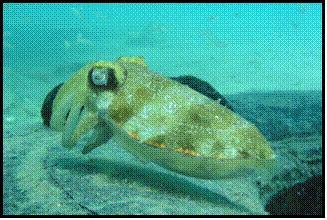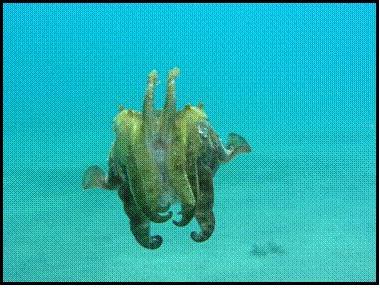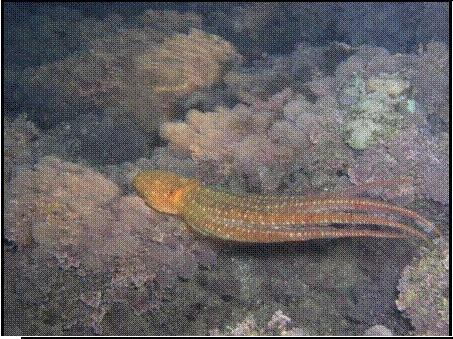The class Cephalopoda is one of the most fascinating and special groups in the animal world and presents a respectable selection of unusual features

The class Cephalopoda is one of the most fascinating and special groups in the animal world and presents a respectable selection of unusual features. Their distribution is in all the seas and oceans, from the pillow areas to the mesozoles, and evidence of their existence already exists since the Cambrian period. Representatives from this class constitute the largest invertebrates that have evolved during evolution.
Most of them have 8 or 10 arms near the head (hence the name of the group), some of which are equipped with snap buttons used for movement and pita. The mouth is made of a stiff "beak", often equipped with salivary glands that secrete a toxic substance. Most species also have an internal gland that secretes a black substance, which looks like ink, that is secreted into the water to cover their escape.
Their way of moving is also unique - in addition to their ability to swim in the body of water by the edges of the cloak that have been extended into fins or by contracting their arms, they also have the ability to move jet - extremely fast progress as a result of "shooting" a jet of water through the deck (tubular channel).

However, among the unique properties of the head-feet, their amazing ability to change the color patterns and texture of the skin with incredible speed and record precision stands out. Their camouflage and hiding methods rely on this unique feature and they use it to go out of sight of a potential predator in their natural environment.
This may be an adaptation that occurred a long time ago in early cephalopods, from the Coloidae, as a response to losing a massive shell for their protection (Messenger, 1974). Therefore, similar to many gram fish, the cephalopods developed a camouflage system that reflects the ambient light and makes it difficult to distinguish them. In addition, a complementary and active system has also been developed, which adapts the brightness of the skin and body models to those of the environment.
The unusual patterns and the ability to control them are due to the presence of chromatophore cells scattered on the surface of the skin. The expansion of these cells results from the action of tiny muscle cells in their periphery. When the muscle contracts the chromatophore is pulled out and when the muscle is relaxed the pigment is concentrated inside and less visible to the outside. The muscle cells surrounding the chromatophores are controlled by the nervous system and probably also by hormones, with sight being the initial central stimulus.

However, many studies have shown that most cephalopods are color blind (Orlov & Byzov, 1961,1962, 1968; Hamasaki, 1973; Messenger et al, XNUMX), which raises the question of how they are able to control the color of their skin and adapt so perfectly to their environment.
The color changes and body patterns are not only used for camouflage - many species use color patterns accompanied by body movements for the purposes of intrasexual communication and courtship behavior in particular. Often the body color changes as a response to some disturbance, not exactly for camouflage purposes. The common squid Loligo vulgaris, for example, is normally pale in color, but darkens itself when disturbed by an external factor. Many other cephalopods, including octopuses and cuttlefish, wear dark circles around the eyes when disturbed.
The most impressive repertoire of color patterns and body positions appears during courtship. In Sepia officialis, for example, the male displays a striped color pattern and swims over the female making displays that show her his identity and intentions. This performance is also addressed to other males, until one of the contestants withdraws.
This work will deal with various aspects of changing body patterns in several cephalopod species, for the purposes of camouflage and communication between different individuals.

Using the body models for camouflage and hiding
Below are 2 definitions that complement each other for the concept of "camouflage", in such a way that describes well the camouflage of the head and feet:
- According to Edmunds (Edmunds, 1974) - "An animal is camouflaged when it simulates part of its environment and therefore becomes hidden (cryptic)"
- According to Endler (Endler, 1991) - "a color or pattern is cryptic if it simulates a random pattern from the visible background, as perceived by the predator at the time and place where the prey is exposed to predation".
Holmes (Holmes, 1940) was the first to notice and describe adaptive color characteristics in the cuttlefish Sepia officialis. He showed that individuals placed in a container with a dark sandy bottom on which large bright shells were scattered created a disruptive color pattern depending on the soil.
According to Hanlon and Messenger (Hanlon & Messenger, 1988) the color patterns of the body are divided into three categories:
- Uniform - the whole body presents a single and uniform pattern.
- Spotted - dark spots of irregular shapes and uneven sizes covering the body.
- Disruptive - an example (or examples) with high contrast that "breaks" the uniform appearance of the body. A common "disruptive" pattern is a single bright square that appears in the center of the cloak.
The pattern chosen at a given time depends on the visual information received by the animal and the way this information is perceived. Following Holmes' distinction from 1940, Hanlon and Chiao (Hanlon&Chiao, 2001) tried to determine which characteristics of the visual stimulus cause the cuttlefish to change the pattern from uniform to disruptive. For this purpose, they kept 6 young cuttlefish of the species Sepia pharaonis in seawater tanks with a bottom showing an artificial background created by a computer program. The artificial background that was presented was designed to simulate the substrate that Holmes described in his research - a dark background with light spots. Several parameters were changed during the experiments, including the density of the white spots, their size, their shape and the intensity of their brightness.
The reaction expressed in the pattern shown by the cuttlefish was classified qualitatively into one of 3 levels:
- Uniform pattern, without a disruptive stain.
- Disruptive but indistinct pattern.
- A distinctly disruptive pattern.
From the results of their research it can be seen that on a certain substrate the animals "wear" color patterns that are suitable for their effective camouflage: on a substrate of light spots on a dark background a disruptive phenomenon will be displayed that is affected by the density of the spots on the substrate, their size and brightness, but in general is not affected by their shape or color , as long as they are bright relative to the background.
How do cephalopods create color patterns that match their surroundings without distinguishing colors?
Many cephalopods, and octopuses in particular, show an extraordinary ability to adapt their body color to their immediate environment. Surprisingly, there is much evidence that most of them are color blind and are unable to distinguish the different colors of the environment at all. How, then, does their skin color match the wavelengths of light reflected from objects in the environment?
In a study from 1973 (Messenger et al, 1973) it was suggested that they do this not actively by the activity of the chromatophores but by utilizing structures in the skin that work so that light that strikes them is automatically reflected, at the appropriate wavelength. These structures are the iridophores and the leucophores, multi-layered structures based on almost ideal reflectors, which reflect light at any wavelength.
When mature octopuses and squids were exposed to monochromatic light at different wavelengths (Messenger, 1974) many chromatophores contracted and exposed the lower layer of the reflector cells, the iridophores and the leucophores. As a result, the light reflected from different parts of the body matched the light at the projected wavelength. This effect is enhanced when the chromatophore layer is completely contracted and their activity is neutralized. By cutting the nerve fibers that control the chromatophores on one side of the mantle, they showed that a better match was achieved to the wavelengths radiated on this side of the mantle than on the other side, where chromatophore activity is normal.
Another fact that supports this hypothesis is that in many species the pigments in the chromatophores are limited only to the red side of the spectrum. For example, Octopus vulgaris has two types of chromatophores - dark (black or black-red) and light (orange-yellow). In Sepia officialis there are three types - black-brown, red-orange and orange-yellow. In these species, the chromatophores do not contain green, blue and purple pigments, so it is impossible for them to produce colors with shorter wavelengths than yellow. Hence, they can only be used to imitate colors of yellowish sand or brown rocks, while in practice the animals show a wide range of colors on the other side of the spectrum as well.
If so - the squids and octopuses do not respond at all to the different wavelengths of the substrate to regulate the operation of the chromatophores. The wavelengths reflected from the substrate are reflected in the passive reflection of the light in the reflector cells, while the role of the chromatophores is to create patterns on the skin that result from the absorption of different brightnesses from the substrate - the stronger the contrast in the substrate, the more emphasized the pattern displayed by the animal.
The optimal camouflage is obtained from a combination of imitating the color of the substrate by the reflectors (iridophores and leucophores) and the creation of skin patterns influenced by the chromatophores, under the control of the nervous system (Marshall & Messenger, 1996).
Using skin patterns as visual communication markers
Most cephalopods display a wide variety of visual patterns used for camouflage and intrasexual or intersexual communication (Hanlon&Messenger, 1996). These patterns can be considered as communication signs whenever they influence the behavior of another animal (Mynard Smith&Harper, 1995). The expression of these signs is not random but structured and intentional and reflects some kind of situation in the individual showing them. According to Hanlon and Messenger (Hanlon & Messenger, 1988) the body patterns that make up these signs contain four types of components:
- Chromatic components - skin color and patterns on the surface of the skin.
- Skin texture - rough/smooth, etc.
- position
- movement
In intensive monitoring of cuttlefish of the species Sepia officialis they identified about 34 characteristic chromatic components (ie 34 characteristic skin patterns), 6 textural, 8 postural and 6 movement. That is, a total of 54 ingredients that create, in different combinations, a large number of different body patterns.
Cephalopods living in shallow water (such as the common cuttlefish) communicate mainly by chromatic and movement signs (Hanlon & Messenger, 1996), where color is probably not important since, as mentioned, most cephalopods are color blind.
The speed with which the cephalopods exchange these signs is amazing and together with a large repertoire of signs in certain species, such as the Caribbean squid (Sepioteuthis sepioidea) have led to the idea that this is actually a kind of "language" with a defined number of "words". Following the work of Hanlon and Messenger described above, another group of researchers tried to characterize the extent to which these signs are used for intrasexual communication (Crook et al, 2002). With the help of computer tracking of four young cuttlefish, defined instances were mapped that were used when interacting between two individuals. The computer program that tracked the instances calculated the probabilities of using the various instances during the interaction. Each instance consists of a certain combination of the 54 elements of Hanlon and Messenger, and it is understood that the number of possible instances is very large.
However, in graph number 1 you can see that in practice only 12-14 instances were used. This figure corresponds to the qualitative distinction of a messenger who, based on eye observations alone, estimated about 13 occurrences of this species.
These data suggest the possibility that during intrasexual communication between two individuals a squid "language" of 12-14 "words" was used, out of a much larger possible vocabulary.
Summary
Whether for communication or camouflage, it is clear that cephalopods use a unique and rare system that is responsible, in part, for their evolutionary success as a highly prosperous group. Ironically, it is precisely these features that make it difficult to study these animals in their natural environment and most of the studies were conducted in captivity, under controlled laboratory conditions. It can be assumed that in nature the repertoire of displays and body patterns is much larger and more complex than that presented in laboratory conditions in response to a limited number of stimuli.
My personal observations (photographed of course in the natural environment of the head and feet) added to the work strengthen this assumption and the very fact that in a handful of random photographs it is possible to clearly distinguish behaviors and models that were described in laboratory experiments certainly gives (from my personal point of view of course) a different validity to the "dry" information obtained in the laboratory experiments.
All the graphs and charts that Gore writes about are found In the original article on his website "above and below the water"
About the author
Amir Gur is a graduate of a master's degree in marine biology, and the author of the book "Underwater - 44 diving sites in Israel"
To download defines fish and invertebrates You are invited to enter his personal blog: above and below the water.
For a previous article by Amir Gur on the subject of life at sea: Lassepsian Immigration Office
Bibliography
- Chiao, CC and Hanlon, RT (2001) Cuttlefish camouflage: visual perception of size, contrast and number of white squares on artificial checkerboard substrata initiates disruptive coloration. J. Exp. Biol. 204, 2119-2125.
- Chiao, CC and Hanlon, RT (2001) Cuttlefish cue visually on area – not shape or aspect ratio – of light objects in substrate to produce disruptive body patterns for camouflage. Biol. Bull. 201, 269-270.
- Crook, AC (2002) Identifying the structure in cuttlefish visual signals. Phil. Trans. R. Soc. Lond. B. 357, 1617-1624.
- Grable, MM and Shashar, N. (2002) Cuttlefish body patterns as a behavioral assay to determine polarization perception. Biol. Bull. 203, 232-234.
- Hanlon, RT and Messenger, JB (1988). Adaptive coloration in young cuttlefish (Sepia officinalis L.): the morphology and development of body patterns and their relation to behavior. Phil. Trans. R. Soc. Lond. B 320, 437-487.
- Hanlon, RT and Messenger, JB (1996) Cephlopod behaviour. Cambridge university press.
- Holmes, W. (1940). The color change and color patterns of Sepia officinalis L. Proc. Zool. Soc., Lond. 110, 2-35.
- Marshall, NJ and Messenger, JB (1996) Color-blind camouflage. Nature 382, 408-409.
- Mathger, LM and Denton, EJ (2001) Reflective properties of iridophores and fluorescent "eyespots" in the loliginid squid Alloteuthis subulata and Loligo vulgaris.J. Exp. Biol. 204, 2103-2118.
- Maynard Smith, J. and Harper, DGC (1995) Animal signals: models and terminology. J. Theor. Biol. 177, 305-311.
- Messenger, JB (1974) Reflecting elements in cephalopod skin and their importance for camouflage. J. Zool., Lond. 174, 387-395.
- Vecchione, M. and Young, RE (2001) Worldwide observations of remarkable deep-sea squids. Science. 294, 2505-2506.

6 תגובות
This also belongs to the topic:
http://www.ted.com/talks/lang/eng/bonnie_bassler_on_how_bacteria_communicate.html
Michael sharply asked a correct and interesting question that casts doubt on some of what is written in the article (this doubt refers of course to the sources).
I was amazed to see, I think at NGC, how squids communicate with humans. They are in a laboratory aquarium and react to the appearance of humans. Furthermore - the cuttlefish was shown a chessboard some distance from the aquarium and it covered its skin with the exact squares of a chessboard. In another program, Dunon was shown an A and he drew an A on his skin. In these experiments, as can be understood from the description, no colors were involved.
Depth - literally 🙂
Well done for the investment and depth!
I enjoyed the writing.
Interesting article.
One question that bothers me is related to the exact activity of the reflector cells.
After all, what is needed for camouflage is usually the repetition of the light pattern visible from the other side of the body or around it, and not the one coming from the direction of the observer.
How does it work out?
Does the business only work when the octopus is in an environment where the same light comes from many directions - like inside a cave or between rocks?
Of course, I would like to believe that the reflection of the light is not direct, but that it breaks the light and returns the light coming from the sides to the face.
Is it possible that the octopus made part of the way that we are trying to find in recent years to create the "maidens cloak" that causes the light rays to "bypass" the body?
In a word, irony.